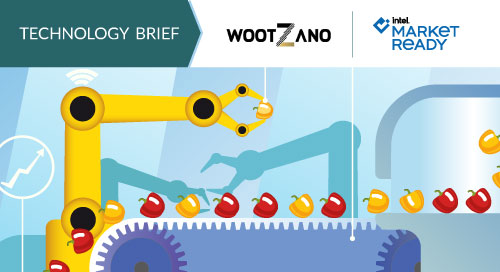Fill form to unlock content
Error - something went wrong!
Get the latest updates on IoT for industrial.
You are following this topic.
AI Robots Use Vision and Touch to Pack Produce

Robots have mastered sight and sound, and new technology is helping them fine-tune their sense of touch for a surprising use case. With a background in electronics, engineering, and bionanotechnology, Dr. Atif Syed was fascinated with nano-scale devices that can have a massive impact on processes. This focus led Syed, the CEO of Wootzano, a UK-based robotics company, to create an electronic skin for robots that enables awareness of pressure sensitive contact.
“I knew that one of the biggest issues was giving robots the sense of real touch like humans have,” he explains. “The electronic skin sensors can feel how much force is applied and the exact direction of a motion. The most interesting part is that this capability is on a completely stretchable material.”
Syed’s goal was to use his innovative new technology in medicine, but he took an unexpected detour, finding a valuable application in the food distribution industry with a potential for supply chain digital transformation.
IoT Machine Learning Transforms an Industry
Traditional methods of picking, trimming, and packing produce are prone to human error, impacting quality and operational efficiency.
“I saw first-hand how difficult it is to find labor to do these tasks and now almost everything is autonomous or automated,” says Syed. “But the fine motor skills needed to pick products without bruising and damaging them couldn’t be fully automated because robots don’t have a fine enough sense of touch.” Since the job is mundane and laborious, the industry is also challenged by high turnover and recruiting expenses.
“Pack houses work with agencies, and employees often come in for a short period of time and then move onto another job,” says Joel Budu, machine learning engineer for Wootzano. “Whatever training you did with that person is more or less gone, and the quality of the output of the work that they do varies as a result.”
Robotic systems equipped with Syed’s electronic skin, like Wootzano’s Avarai, can take over the process, packing produce more efficiently to help improve profit margins and get food from farm to table faster and fresher. The robots can also identify a quality issue before food is sent to the retailer, reducing returns and waste.
How Industrial Automation and IoT Work
Wootzano’s Avarai system is a standalone solution that can be added to an existing conveyor system. Instead of just offering a robotic hand like other systems, Avarai is a complete solution with vision, automation, and the electronic skin that plays a pivotal role, checking for freshness by analyzing data including firmness, chemical sensing, and temperature. The pick tool on the end-effector is customizable, allowing customers to change their system to fit the requirements of their produce (Video 1).
Avarai robots are equipped with AI and IoT machine learning. Every product that passes through the robot cameras is recorded and analyzed. Data is stored onto an AWS cloud network. Grapes, for example, are one of the most complex fruits to pick and process, and Avarai offers an ROI of roughly just under a year.
“Avarai is very easy to integrate into existing equipment,” says Budu. “The cabinet structure that contains the brains of the robots can fit into a 600-millimeter square space. We use Intel® RealSense™ cameras to capture depth images. And our solution uses a lot of Intel® hardware, including CPUs for the PC and VPUs for the machine learning inference.”
Packers purchase the robot and enroll in a monthly subscription fee, which covers the machine learning models, hardware updates, repairs and maintenance, and replacement of electronic skin.
“Depending on usage, the e-skin needs replacement about every four months,” says Syed. “Unfortunately, unlike human skin, the robot skin doesn’t regenerate itself—yet.”
“The main benefit we are giving to our customers is the fact that they don’t need to rely on human labor which is a big challenge for the industry at present given labor shortages and the ongoing COVID pandemic,” says Syed.
#Robotic systems equipped with electronic skin, like @Wootzano’s Avarai, can help improve profit margins and get food from farm to table faster and fresher. via @insightdottech
The Future of IoT Robots
Syed’s next goal is to democratize robots and get them to a price point that makes sense for customers—both commercial and consumer. He says democratization will expand what’s possible.
“We see a future where there are more robots in people’s homes,” he says. “Today, consumers have robot lawn mowers, robot vacuum cleaners, and even robot litter boxes that clean themselves. We envision one that cooks your favorite meal for you! Our biggest innovation is bringing the cost down to enable customers to adopt technologies and integrate them as quickly as we can. We believe in a world where people have more free time to do the things they love.”
This article was edited by Georganne Benesch, Associate Content Director for insight.tech.